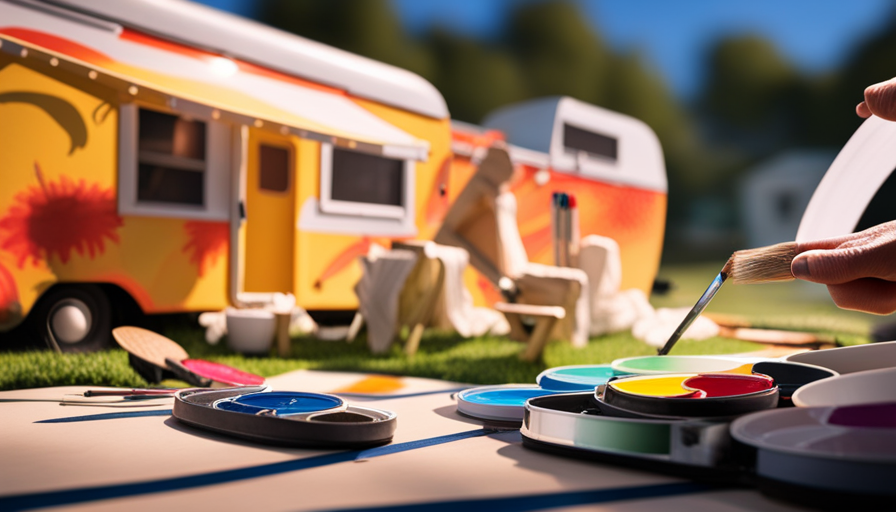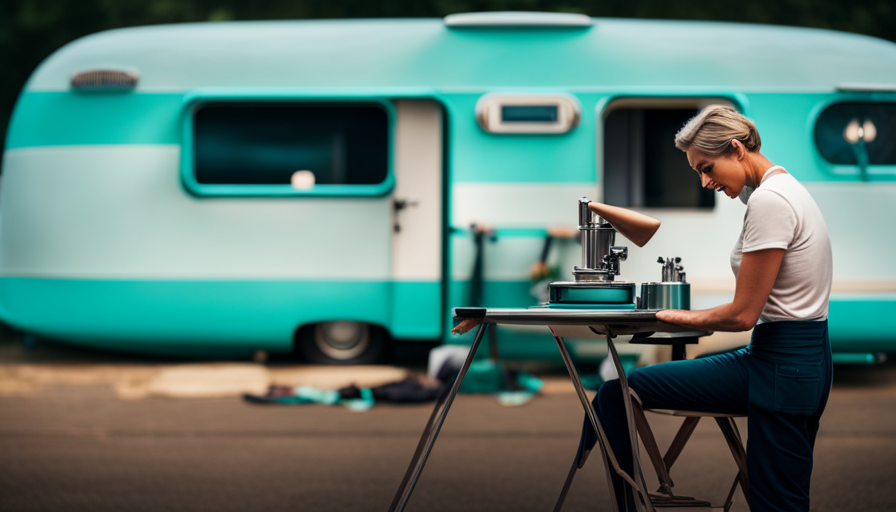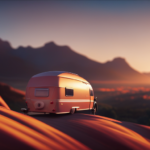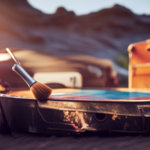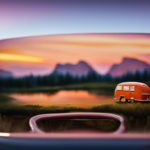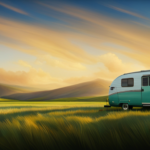Prepare to turn your pop-up camper into a masterpiece!
Painting a pop-up camper is not only a fun and creative project, but it can also give your camper a fresh new look that will turn heads at the campground.
In this guide, I will walk you through the step-by-step process of painting your pop-up camper, from assessing its condition to applying the final coat.
Now, I know what you’re thinking – painting a pop-up camper sounds like a daunting task, but fear not! With the right paint and supplies, a little bit of elbow grease, and some patience, you’ll be able to achieve professional-looking results that will make your camper the envy of fellow campers. First, you’ll want to start by thoroughly cleaning the exterior of the camper to ensure that the paint adheres properly. Use a mild detergent and water to remove any dirt, grime, or debris, and consider using canvas cleaning tips for any fabric sections of the camper. Once the surface is clean and dry, you can begin the painting process. Just remember to take your time and follow the instructions on the paint and supplies you choose for the best results. With a little effort, your pop-up camper will look brand new in no time!
So, grab your paintbrush and let’s get started on this exciting journey of giving your pop-up camper a vibrant and eye-catching makeover!
Key Takeaways
- Assess the condition of the camper before painting and make any necessary repairs or address water damage.
- Choose the right paint and supplies, such as acrylic latex paint designed for outdoor use.
- Use proper painting techniques, including cleaning and sanding the surface, applying multiple thin coats, and using painter’s tape for clean lines.
- Remove and protect interior items to prevent damage, and reinstall them after painting.
Assess the Condition of Your Pop-up Camper
Before you start painting your pop-up camper, take a close look and assess its overall condition to ensure a smooth and successful painting process. Assessing repairs and checking for water damage are crucial steps in this process.
Begin by examining the exterior of the camper for any signs of wear and tear. Look for cracks, dents, or holes that may need to be repaired before painting. Pay special attention to the roof, as it’s often the most vulnerable to water damage. Inspect the seams and corners for any signs of leaks or water stains. If you find any damage or water infiltration, make sure to fix it before proceeding with the painting.
Next, inspect the interior of the camper for any structural issues or water damage. Check the flooring, walls, and furniture for any signs of rot or mold. It’s essential to address these issues before painting to ensure a stable and healthy environment inside the camper.
Once you’ve assessed and addressed any necessary repairs, you can move on to choosing the right paint and supplies for your pop-up camper.
Choose the Right Paint and Supplies
When it comes to transforming your camper into a work of art, you’ll need to make sure you have all the necessary supplies to create a vibrant and eye-catching masterpiece. Choosing the right paint type is crucial to achieving the desired result.
Acrylic latex paint is a popular choice for its durability and ease of use. It’s important to select a paint that’s specifically designed for outdoor use to ensure it can withstand the elements. Additionally, consider using a primer before applying the paint to ensure better adhesion and longevity.
Using proper painting techniques is equally important in achieving a professional-looking finish. Start by thoroughly cleaning and sanding the surface to create a smooth and even canvas. Use a high-quality brush or roller to apply the paint, ensuring even coverage and avoiding drips or streaks. Apply multiple thin coats rather than one thick coat for better results. Consider using painter’s tape to create clean lines and protect any areas you don’t want to paint.
Incorporating these tips will help you choose the right paint and use proper painting techniques to transform your pop-up camper. Once you’ve completed this step, you can move on to the next section about removing and protecting interior items.
Remove and Protect Interior Items
As you embark on the transformation of your camper, it’s time to carefully remove and safeguard the cherished items within its cozy interior. Before you start painting, it’s crucial to protect your furniture and cover delicate items to prevent any damage.
Start by removing any loose or detachable items such as curtains, cushions, and decorations. Store them in a safe place away from the painting area to avoid any accidental spills or splatters. For items that can’t be removed, like built-in furniture or appliances, cover them with plastic sheets or drop cloths. This will shield them from any paint drips or overspray.
Additionally, consider using painter’s tape to cover any edges or corners that you want to keep paint-free. This will ensure clean lines and a professional finish. Take extra care when covering delicate items such as mirrors, glass surfaces, or electronics. Use bubble wrap, newspaper, or cardboard to provide an extra layer of protection.
Once you have successfully removed and covered all interior items, you can move on to prepping the exterior surface.
Now that your interior is safe and protected, it’s time to focus on preparing the exterior surface for painting.
Prep the Exterior Surface
To prep the exterior surface of my pop up camper, I begin by sanding and priming the entire surface. This helps to create a smooth and even base for the paint to adhere to.
Next, I carefully inspect the exterior for any cracks or imperfections and fill them in with putty or filler. This step ensures that the final paint job will look seamless and professional.
Sand and prime the exterior of your camper
Start by sanding and priming the exterior of your pop-up camper for a flawless paint job. Choose the right sandpaper, around 120 to 150 grit, to remove old paint or imperfections. Sand in a circular motion, covering the entire surface area. Once sanding is complete, wipe away dust or debris with a clean cloth.
Next, apply a primer coat effectively. Use a high-quality primer specifically designed for outdoor use and compatible with your chosen paint. Apply the primer evenly with a paintbrush or roller. Allow it to dry completely before moving on to the next step. This will create a strong base for the paint and ensure better adhesion.
Now you can smoothly transition into the next section about filling in any cracks or imperfections with putty or filler.
Fill in any cracks or imperfections with putty or filler
Smooth out any rough spots on the surface of your camper by filling in cracks and imperfections with putty or filler, like a sculptor carefully molding clay to create a masterpiece.
To ensure a flawless finish, it’s crucial to choose the right filler for the job. Opt for a high-quality filler that’s specifically designed for exterior use and can withstand the elements.
Before applying the filler, make sure to clean and dry the area thoroughly. Apply the putty using appropriate techniques, such as using a putty knife to smoothly spread it over the cracks.
Once the filler is applied, allow it to dry completely before sanding it down to create a seamless surface. This step is essential to achieve a professional-looking paint job.
With the cracks and imperfections filled, we can now move on to applying the base coat.
Apply the Base Coat
To ensure better adhesion of the paint, I always start by applying a primer coat. This helps create a smooth and even surface for the base coat.
Once the primer is dry, I then proceed to apply the base coat of paint evenly and smoothly. This step is crucial to achieve a professional-looking finish and to ensure that the color is applied uniformly across the entire surface of the pop-up camper.
Start with a primer coat for better adhesion
For better adhesion, it’s best to begin by applying a primer coat when painting a pop-up camper. This step is crucial as it helps the paint adhere properly and ensures a smooth and long-lasting finish. Here are some tips for achieving a flawless result:
-
Choosing the right primer: Opt for a high-quality primer that’s specifically designed for use on the type of material your camper’s made of. This’ll enhance adhesion and prevent peeling or chipping.
-
Clean and prepare the surface: Before applying the primer, thoroughly clean the camper’s exterior to remove any dirt, grease, or old paint. Sanding the surface lightly’ll also help the primer adhere better.
-
Use a roller or brush: Apply the primer evenly using a high-quality roller or brush. Make sure to cover all surfaces, including corners and edges.
-
Allow proper drying time: Follow the manufacturer’s instructions for drying time. This’ll ensure that the primer fully cures and creates a solid base for the paint.
-
Sand and smooth: After the primer’s dried, lightly sand the surface to remove any imperfections and create a smooth canvas for the base coat.
By starting with a primer coat, you set the foundation for a flawless paint job.
Now, let’s move on to applying the base coat of paint evenly and smoothly.
Apply the base coat of paint evenly and smoothly
After applying a primer coat to my pop-up camper, it’s time to move on to the next step: applying the base coat of paint. This is a crucial step in achieving a professional and polished look.
To ensure a smooth and even application, I recommend using a high-quality brush or roller. Start by loading the brush or roller with paint, making sure to remove any excess. Begin applying the paint in long, even strokes, working from top to bottom and side to side. Take your time and be mindful of any drips or uneven areas.
As for the paint color, choose one that complements the overall design scheme of your camper.
Now that the base coat is complete, we can move on to adding color and design, bringing our pop-up camper to life.
Add Color and Design
When it comes to adding color and design to your pop-up camper, the first step is to choose your desired color scheme or design. Whether you prefer a bold and vibrant look or a more subtle and calming atmosphere, selecting the right colors will set the tone for your camper’s interior.
Once you have your colors in mind, use stencils or painter’s tape to create clean lines and patterns for a professional and polished finish.
Choose your desired color scheme or design
To add a touch of creativity and personality, go ahead and pick your favorite color scheme or design for your pop-up camper. Here are some color scheme ideas and design inspirations to consider:
-
Retro Vibes: Embrace the nostalgia with bold, vibrant colors like aqua blue, sunny yellow, and cherry red. Add geometric patterns and vintage-inspired accents for a fun and playful look.
-
Nature-Inspired: Bring the outdoors inside by opting for earthy tones like moss green, warm brown, and soft beige. Incorporate natural elements like leaf motifs or floral patterns for a serene and calming atmosphere.
-
Minimalistic Elegance: If you prefer a clean and modern aesthetic, choose a monochromatic color scheme such as shades of gray or white. Add pops of color with accessories and artwork for a sleek and sophisticated vibe.
Now that you have your desired color scheme or design in mind, let’s move on to the next section about using stencils or painter’s tape for clean lines and patterns.
Use stencils or painter’s tape for clean lines and patterns
Let’s explore how stencils or painter’s tape can help you achieve clean lines and patterns in your chosen color scheme or design. Can you imagine the possibilities for adding intricate details to your camper’s interior?
Stencil techniques are a great way to create precise and professional-looking designs on your camper walls or furniture. You can find a wide variety of stencil designs to choose from, or even create your own custom stencils. Simply secure the stencil to the surface using painter’s tape, and then carefully apply paint with a brush or sponge.
Painter’s tape is also useful for creating geometric or striped designs. Just apply the tape in the desired pattern, paint over it, and remove the tape for clean and crisp lines. With these stencil techniques and masking tape designs, you can easily add beautiful patterns and details to your camper’s interior.
Now, let’s move on to the next step of applying multiple coats for a flawless finish.
Apply Multiple Coats
Applying multiple coats of paint on your pop-up camper ensures a professional finish that will withstand the test of time. It’s important to take the time to properly prepare the surface and apply each coat evenly for the best results. Here are a few tips to consider when applying multiple coats of paint to your camper:
-
Applying clear coat: Once you’ve finished painting your desired color, it’s essential to apply a clear coat. This protective layer adds a glossy finish and helps seal and protect the paint from fading or peeling.
-
Using different paint finishes: To add depth and visual interest to your camper, consider using different paint finishes. For example, you could use a matte finish on the main body of the camper and a glossy finish on the trim. This contrast can create a stunning visual effect.
Nested Bullet Point List:
-
The clear coat not only enhances the appearance of the camper but also provides an added layer of protection against UV rays, dirt, and moisture.
-
Different paint finishes can give your camper a unique and customized look, making it stand out from the crowd and reflecting your personal style.
By applying multiple coats of paint and utilizing different finishes, you can achieve a professional and long-lasting result for your pop-up camper. Once the paint is dry and the clear coat is applied, it’s time to move on to the next step of sealing and protecting your camper for years of enjoyment and adventure.
Seal and Protect
After properly preparing and applying multiple coats of paint, it’s crucial to seal and protect your pop-up camper for long-lasting durability. Protecting the exterior and maintaining the paint job are essential steps in ensuring your camper stays in great condition. To accomplish this, there are several key actions you can take.
Firstly, applying a clear coat sealant will provide an extra layer of protection against the elements. This sealant acts as a barrier, shielding your camper from UV rays, moisture, and other potential damage. Additionally, it helps to prevent fading and cracking, keeping your paint job looking fresh for years to come.
Another important step is to regularly clean and wax your camper. This not only enhances its appearance but also helps to protect the paint from dirt, debris, and oxidation. By applying a high-quality wax, you create a protective barrier that repels water and prevents the buildup of contaminants.
To summarize these steps, refer to the table below:
| Steps to Seal and Protect |
|---|
| Apply clear coat sealant |
| Regularly clean and wax |
By following these guidelines, you can ensure the exterior of your pop-up camper remains protected and the paint job stays vibrant. In the next section, we will discuss how to reinstall interior items, completing the process of refreshing your camper’s look and functionality.
Reinstall Interior Items
First, I clean and reorganize the interior of my camper, making sure to remove any dirt or debris that may have accumulated during the painting process. I vacuum the floors, wipe down the surfaces, and clean any upholstery or curtains.
Next, I carefully put back any fixtures or furniture that were removed before painting. I make sure everything’s securely fastened and in its proper place, ensuring that the interior of my camper is both functional and aesthetically pleasing.
Clean and reorganize the interior of your camper
To transform your pop-up camper, start by giving the interior a thorough cleaning and reorganizing it for a fresh and organized look. Here are some tips for maximizing storage space in your camper and creating a cozy and inviting interior:
-
Utilize vertical space: Install hanging organizers or shelves to make the most of wall space for storing items like kitchen utensils, toiletries, and small appliances.
-
Optimize under-bed storage: Invest in storage containers that fit neatly under the bed to store bedding, clothing, and other bulky items.
-
Use multi-purpose furniture: Look for furniture pieces that serve dual purposes, such as a table that can also be used as a storage compartment.
-
Add personal touches: Incorporate decorative elements like throw pillows, rugs, and curtains to create a warm and inviting atmosphere.
Once the interior is clean and reorganized, you can proceed to put back any fixtures or furniture that were removed.
Put back any fixtures or furniture that were removed
After thoroughly cleaning and reorganizing the interior of my pop-up camper, it was time to put back all the fixtures and furniture that I’d removed. This step is crucial in ensuring that everything’s in its proper place and ready for use.
One task I tackled was reupholstering the cushions to give them a fresh and updated look. I carefully selected a durable and stylish fabric that’d withstand the wear and tear of camping adventures.
Additionally, I took the opportunity to update the lighting fixtures, replacing old and outdated ones with energy-efficient LED lights for a brighter and more modern feel.
With the reupholstered cushions and updated lighting fixtures in place, my pop-up camper was starting to feel like a brand new space.
Now, it was time to move on to the next exciting step: enjoying my newly painted pop-up camper and creating unforgettable memories.
Enjoy Your Newly Painted Pop-up Camper
Congratulations on your beautifully painted pop-up camper – now it’s time to kick back, relax, and enjoy the fruits of your labor! Adding a fresh coat of paint to your camper not only gives it a new lease on life but also allows you to express your personal style. By choosing the right paint color and adding personal touches, you can transform your camper into a cozy and inviting space that reflects your unique taste.
To help you make the most of your newly painted pop-up camper, here are some tips and ideas:
| Create a Cozy Lounge Area | Add a Touch of Nature |
|---|---|
| Place comfy cushions and | Bring the outdoors inside |
| pillows on the seating area | with potted plants or |
| for ultimate relaxation. | hanging terrariums. |
| Hang Twinkling Lights | Display Personal Mementos |
|---|---|
| String fairy lights around | Showcase your travels and |
| the interior to create a | adventures by displaying |
| magical and cozy ambiance. | souvenirs and photographs. |
Remember, the key to enjoying your newly painted pop-up camper is to make it your own. Let your creativity shine through by incorporating personal touches that reflect your personality and interests. Whether it’s a favorite color, a cherished memento, or a cozy reading nook, make your camper a home away from home. So go ahead, relax, and savor the joy of your beautifully transformed pop-up camper!
Frequently Asked Questions
Can I paint my pop-up camper if it has existing damage or rust?
Yes, you can still paint your pop-up camper even if it has existing damage or rust. However, it’s important to properly repair and treat the damaged areas before painting. This will ensure that the paint adheres well and provides a smooth finish.
To prevent rust on a painted pop-up camper, it’s crucial to apply a suitable primer and a high-quality paint that offers protection against corrosion. Regular maintenance and inspections are also essential to identify and address any new damage or rust.
What type of paint should I use for the exterior of my pop-up camper?
For the exterior of your pop-up camper, I recommend using a high-quality acrylic paint. It offers excellent durability and weather resistance.
When it comes to painting techniques, start by thoroughly cleaning and sanding the surface to ensure proper adhesion. Then, apply a primer specifically designed for use on metal surfaces. Finally, apply two to three coats of your chosen paint brand, allowing each coat to dry completely before applying the next.
Some popular paint brands for camper exteriors include Rust-Oleum, Krylon, and Valspar.
How do I safely remove and protect the windows and doors while painting?
When it comes to safely removing and protecting the windows and doors while painting, there are a few important safety precautions to keep in mind. First, make sure to wear gloves and safety glasses to protect yourself from any potential injuries.
Next, carefully remove any hardware, such as screws or hinges, from the windows and doors before painting.
Cover the surrounding surfaces with plastic or drop cloths to prevent any accidental paint splatters.
Finally, consider using painter’s tape to protect the edges of the windows and doors from paint drips.
Is it necessary to sand the exterior surface before applying the base coat?
Sanding the exterior surface before applying the base coat is highly important. It helps to create a smooth and even surface for the paint to adhere to, ensuring a long-lasting and professional-looking finish. Sanding also helps to remove any existing paint or imperfections, allowing the base coat to adhere properly.
While there are alternative methods such as using a chemical paint stripper, sanding is recommended for the best results.
How long should I wait between applying multiple coats of paint?
I’m no expert, but when it comes to applying multiple coats of paint, patience is key. You want to make sure each coat has enough time to dry before adding another layer. The drying time can vary depending on factors like humidity and paint thickness. Generally, it’s a good idea to wait at least 24 hours between coats to ensure the paint has fully dried and adhered to the surface.
This will help you achieve a professional-looking finish.
What Are the Steps for Painting the Exterior of a Pop Up Camper?
When painting the outside of a camper, the first step is to thoroughly clean and prep the surface. Next, remove any loose paint or rust using a wire brush or sandpaper. Apply a coat of primer specifically designed for metal surfaces. Once dry, choose an exterior paint suitable for camper exteriors and apply it evenly using a brush or roller. Allow sufficient drying time between coats. Finish by applying a clear sealant for added protection and durability.
Conclusion
In conclusion, painting a pop-up camper can be a rewarding and transformative project. By assessing the condition of your camper, choosing the right paint and supplies, and properly prepping the exterior surface, you can achieve a professional-looking finish.
Applying multiple coats and sealing the paint will ensure durability and longevity. So, why not give your camper a fresh new look and turn heads on your next camping adventure? Let your imagination run wild as you envision the endless possibilities of your newly painted pop-up camper.
Happy camping!

